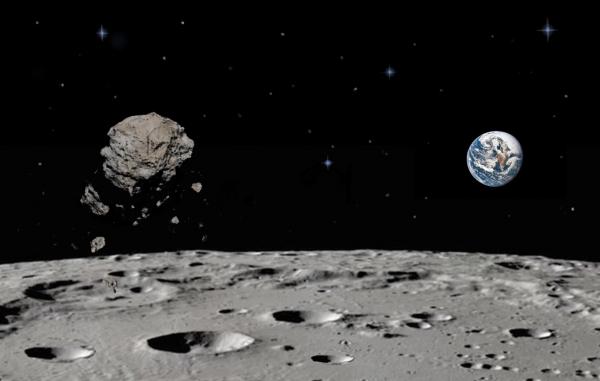A quasi-satellite of Earth, named Kamoʻoalewa, might actually be a chip off our Moon.

Juan A. Sanchez / PSI
The Moon has orbited Earth for billions of years. But in this century, astronomers have discovered five small asteroids that are actually “quasi-satellites” that travel in phase with our planet around the Sun. Now the first detailed observations of a quasi-satellite suggest that it (and perhaps others) might be a chip off the Moon.
Earth’s gravity affects the orbits of quasi-satellites, and they circle the Sun in a year like our planet. But they neither orbit Earth nor come inside the Hill sphere, where terrestrial gravity dominates.
Discovered in 2016, the closest and smallest quasi-satellite, 469219 Kamo‘oalewa (2016 HO3), is the first to come within the observing range of large telescopes. Now five years of observations reported in Nature Communications Earth & Environment show that the 50-meter object has a color surprisingly like that of samples Apollo astronauts collected from the lunar highlands half a century ago. In comparison, very few asteroids have been found to come from the Earth-Moon system, says coauthor Juan Sanchez (Planetary Science Institute).
Not Exactly Satellites
What makes a quasi-satellite an odd duck in the world of asteroids is the gravitational resonance that locks its orbital period with that of Earth or some other planet. The orbit of the much lighter quasi-satellite is more elongated, or eccentric, than that of the planet, so the quasi-satellite spends most of its time inside and outside of the planet’s orbit.

Wikimedia Commons
The quasi-satellite alternately falls behind the planet when it’s on the outside and moves ahead when it’s on the inside. That motion takes the quasi-satellite around the planet but outside of the Hill sphere, the region where a planet’s gravity holds “real” satellites in orbit.
The dynamics of a quasi-satellite orbit are similar to those of a horseshoe orbit, in which an object traces a “U” shape from the planet’s perspective, going from near the L4 Lagrange point to the L3 and L5 points, then back to the L4 point.

Wikimedia Commons; Data: HORIZONS System / JPL / NASA
In fact, objects can easily shift between quasi-satellite and horseshoe orbits: Kamo‘oalewa probably switched from a horseshoe orbit to a quasi-satellite orbit about a hundred years ago and will switch back in another three centuries or so, according to a paper published in Monthly Notices of the Royal Astronomical Society by Carlos and R. de la Fuente Marcos (Complutense University of Madrid) shortly after the asteroid’s discovery.
These shifts can complicate counting how many objects are in each state. Earth currently has five quasi-satellites and about a dozen in horseshoe orbits. Single quasi-satellites have been observed for Venus and Neptune, too. Models show that quasi-satellites could remain around the outermost planets, Uranus and Neptune, for the life of the Sun. Jupiter can sustain quasi-satellites for nearly 10 million years, and Saturn for about 100,000 years.
Hints of a Lunar Origin
Kamo‘oalewa comes near Earth every year around April, allowing both the Large Binocular Telescope and the Lowell Discovery Telescope to collect spectral data at visible and infrared wavelengths. That data has yielded crucial information on the object’s color.
Kamoʻoalewa reflects more light at longer wavelengths of 1.5 to 2.5 microns, Sanchez explains, which makes it more like the samples collected during the Apollo missions and less like other near-Earth asteroids and meteorite samples. He adds that the difference comes from surface composition and the extent of space weathering, in which micrometeorites and solar wind particles change surface materials.
The similarity with lunar samples suggests that Kamoʻoalewa might be a chunk of the Moon, perhaps blasted into space by an asteroid impact. But color is not the only evidence for that scenario. The object’s eccentricity and orbital inclination are also quite small for what is typical of captured objects. When near the Earth-Moon system, Kamoʻoalewa moves at only 10–25% the speed of typical near-Earth asteroids. The slow speed also supports a Moon origin.
Kamo‘oalewa’s close approaches to Earth may offer unique possibilities in the future. The quasi-satellite comes close enough that the China National Space Administration has designated it the target for a complex mission to collect and return samples from an asteroid. Plans call for launch in 2024 and arrival in 2025.
 0
0









Comments
You must be logged in to post a comment.